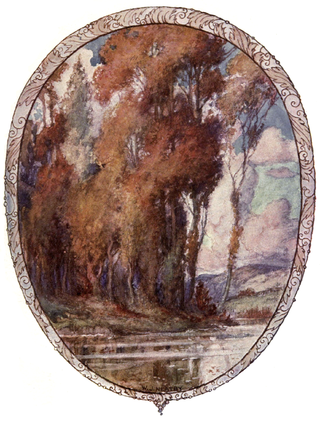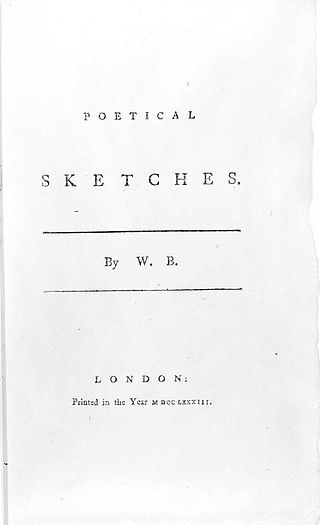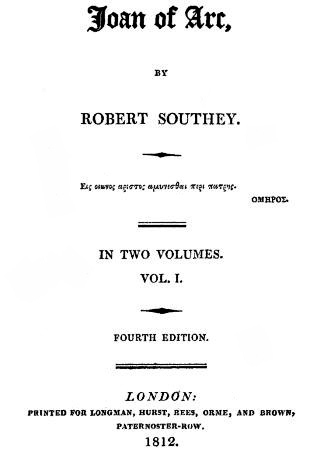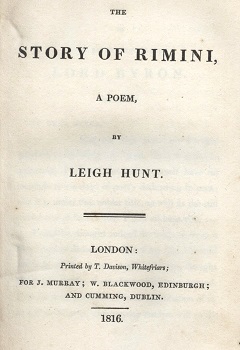
Kubla Khan is a poem written by Samuel Taylor Coleridge, completed in 1797 and published in 1816. It is sometimes given the subtitles "A Vision in a Dream" and "A Fragment." According to Coleridge's preface to Kubla Khan, the poem was composed one night after he experienced an opium-influenced dream after reading a work describing Shangdu, the summer capital of the Mongol-led Yuan dynasty of China founded by Kublai Khan. Upon waking, he set about writing lines of poetry that came to him from the dream until he was interrupted by "a person from Porlock". The poem could not be completed according to its original 200–300 line plan as the interruption caused him to forget the lines. He left it unpublished and kept it for private readings for his friends until 1816 when, at the prompting of Lord Byron, it was published.

James Henry Leigh Hunt, best known as Leigh Hunt, was an English critic, essayist and poet.

"To Autumn" is a poem by English Romantic poet John Keats. The work was composed on 19 September 1819 and published in 1820 in a volume of Keats's poetry that included Lamia and The Eve of St. Agnes. "To Autumn" is the final work in a group of poems known as Keats's "1819 odes". Although personal problems left him little time to devote to poetry in 1819, he composed "To Autumn" after a walk near Winchester one autumnal evening. The work marks the end of his poetic career, as he needed to earn money and could no longer devote himself to the lifestyle of a poet. A little over a year after the publication of "To Autumn", Keats died in Rome.

"Ode to a Nightingale" is a poem by John Keats written either in the garden of the Spaniards Inn, Hampstead, London or, according to Keats' friend Charles Armitage Brown, under a plum tree in the garden of Keats' house at Wentworth Place, also in Hampstead. According to Brown, a nightingale had built its nest near the house that he shared with Keats in the spring of 1819. Inspired by the bird's song, Keats composed the poem in one day. It soon became one of his 1819 odes and was first published in Annals of the Fine Arts the following July. The poem is one of the most frequently anthologized in the English language.
Nationality words link to articles with information on the nation's poetry or literature.
Sonnets on Eminent Characters or Sonnets on Eminent Contemporaries is an 11-part sonnet series created by Samuel Taylor Coleridge and printed in the Morning Chronicle between 1 December 1794 and 31 January 1795. Although Coleridge promised to have at least 16 poems within the series, only one addition poem, "To Lord Stanhope", was published.

"To Fayette" was written by Samuel Taylor Coleridge and published in the 26 December 1794 Morning Chronicle as part of the Sonnets on Eminent Characters series. Coleridge, like other Romantic poets, viewed Gilbert du Motier, marquis de Lafayette as a hero of liberty for his part in the American and French revolutions. The poem coincides with Fayette's imprisonment in Austria, and he is treated as a martyr for liberty. The language Coleridge uses within the poem to describe Fayette and revolutions appears in many of his later works.

"To Kosciusko" is the name shared by three sonnets written by Samuel Taylor Coleridge, Leigh Hunt, and John Keats. Coleridge's, the original, was written in December 1794 and published in the 16 December 1794 Morning Chronicle as the fifth of his Sonnets on Eminent Characters series. Hunt and Keats were inspired to follow his poem with their own versions in November 1815 and December 1816, respectively. The sonnets were dedicated to heroism of Tadeusz Kościuszko, leader of the 1794 Polish rebellion against Prussian and Russian control.

Poetical Sketches is the first collection of poetry and prose by William Blake, written between 1769 and 1777. Forty copies were printed in 1783 with the help of Blake's friends, the artist John Flaxman and the Reverend Anthony Stephen Mathew, at the request of his wife Harriet Mathew. The book was never published for the public, with copies instead given as gifts to friends of the author and other interested parties. Of the forty copies, fourteen were accounted for at the time of Geoffrey Keynes' census in 1921. A further eight copies had been discovered by the time of Keynes' The Complete Writings of William Blake in 1957. In March 2011, a previously unrecorded copy was sold at auction in London for £72,000.

Joan of Arc is a 1796 epic poem composed by Robert Southey. The idea for the story came from a discussion between Southey and Grosvenor Bedford, when Southey realised that the story would be suitable for an epic. The subject further appealed to Southey because the events of the French Revolution were concurrent to the writing of the poem and would serve as a parallel to current events. Eventually, Samuel Taylor Coleridge helped rewrite parts of the poem for a 1798 edition. Later editions removed Coleridge's additions along with other changes.
Hero and Leander is a poem by Leigh Hunt written and published in 1819. The result of three years of work, the poem tells the Greek myth of Hero and Leander, two lovers, and the story of their forlorn fate. Hunt began working on the poem during the summer of 1816, arousing the interest of the publisher John Taylor, and despite repeated delays to allow Hunt to deal with other commitments the poem was finished and published in a collection 1819. Dealing with themes of love and its attempt to conquer nature, the poem does not contain the political message that many of Hunt's works around that time do. The collection was well received by contemporary critics, who remarked on its sentiment and delicacy, while more modern writers such as Edmund Blunden have criticised the flow of its narrative.
Bacchus and Ariadne is a poem by Leigh Hunt written and published in 1819. The result of three years of work, the poem tells the Greek myth of Hero and Leander, two lovers, and the story of their forlorn fate. Hunt began working on the poem during the summer of 1816, arousing the interest of the publisher John Taylor, and despite repeated delays to allow Hunt to deal with other commitments the poem was finished and published in a collection 1819. Hunt later claimed in a poem about Bacchus and Ariadne that he was seeking to humanise myths and make them more understandable to the common people. The collection was well received by contemporary critics and poets, including Thomas Carlyle, while more modern writers such as Edmund Blunden have criticised the flow of its narrative.

Juvenilia; or, a Collection of Poems Written between the ages of Twelve and Sixteen by J. H. L. Hunt, Late of the Grammar School of Christ's Hospital, commonly known as Juvenilia, was a collection of poems written by James Henry Leigh Hunt at a young age and published in March 1801. As an unknown author, Hunt's work was not accepted by any professional publishers, and his father Isaac Hunt instead entered into an agreement with the printer James Whiting to have the collection printed privately. The collection had over 800 subscribers, including important academics, politicians and lawyers, and even people from the United States. The critical and public response to Hunt's work was positive; by 1803 the collection had run into four volumes. The Monthly Mirror declared the collection to show "proofs of poetic genius, and literary ability", and Edmund Blunden held that the collection acted as a predictor of Hunt's later success. Hunt himself came to despise the collection as "a heap of imitations, all but absolutely worthless", but critics have argued that without this early success to bolster his confidence Hunt's later career could have been far less successful.

The Palace of Pleasure is a poem by James Henry Leigh Hunt published in his 1801 collection Juvenilia. Written before he was even sixteen, the work was part of a long tradition of poets imitating Spenser. The Palace of Pleasure is an allegory based on Book II of Edmund Spenser's The Faerie Queene and describes the adventure of Sir Guyon as he is taken by airy sylphs to the palace of the "Fairy Pleasure". According to Hunt the poem "endeavours to correct the vices of the age, by showing the frightful landscape that terminates the alluring path of sinful Pleasure".
The Literary Pocket-Book was a collection of works edited by Leigh Hunt and containing material by Hunt, Percy Bysshe Shelley, John Keats, and Bryan Waller Procter. The collection was put together during 1818, and proved so successful that Hunt was able to sell the copyright for £200 a year later. The collection includes written worked, lined pages to write notes on and lists of authors, artists, schools and libraries. It was a public success, bringing new readers to both Shelley and Keats, and served as a model for other collections of poetry written during the Victorian era. Critical reviews were also excellent, with The London Magazine describing it as "for the most part delightfully written", although Keats himself later wrote that the collection was "full of the most sickening stuff you can imagine".

The Feast of the Poets is a poem by Leigh Hunt that was originally published in 1811 in the Reflector. It was published in an expanded form in 1814, and revised and expanded throughout his life. The work describes Hunt's contemporary poets, and either praises or mocks them by allowing only the best to dine with Apollo. The work also provided commentary on William Wordsworth and Romantic poetry. Critics praised or attacked the work on the basis of their sympathies towards Hunt's political views.

The Story of Rimini was a poem composed by Leigh Hunt, published in 1816. The work was based on his reading about Paolo and Francesca in hell. Hunt's version gives a sympathetic portrayal of how the two lovers came together after Francesca was married off to Paolo's brother. The work promotes compassion for all of humanity and the style served to contrast against the traditional 18th century poetic conventions. The work received mixed reviews, with most critics praising the language.
The Nymphs was composed by Leigh Hunt and published in Foliage, his 1818 collection of poems. The work describes the spirits of a rural landscape that are connected to Greek mythology. The images serve to discuss aspects of British life along with promoting the freedom of conscience for the British people. The collection as a whole received many attacks by contemporary critics, but later commentators viewed the poem favourably.
The Calendar of Nature is a series of articles by Leigh Hunt about aspects of various months and seasons published throughout 1819 in the Examiner. It is also included in his Literary Pocket-Book and published on its own as The Months. The work places emphasis on the season of autumn as a time for justice and prosperity, and influenced John Keats's poem "To Autumn". The emphasis on both works is on a temperate landscape and the positive political aspects of living in such a place. The work also stresses the sickness that is connected to a temperate landscape, which is related to the physical problems that Keats was suffering from at the time.

The sonnet was a popular form of poetry during the Romantic period: William Wordsworth wrote 523, John Keats 67, Samuel Taylor Coleridge 48, and Percy Bysshe Shelley 18. But in the opinion of Lord Byron sonnets were “the most puling, petrifying, stupidly platonic compositions”, at least as a vehicle for love poetry, and he wrote no more than five.












